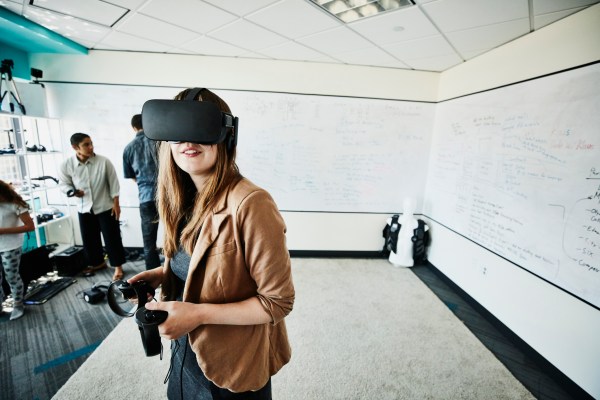As consumer VR begins to have a moment following years of heavy investment from Facebook and other tech giants, corporate America is similarly beginning to find more utility in the technology, as well.
Bank of America announced today that they’ll be working with Bay Area-based VR startup Strivr to bring more of their workplace training into virtual reality. The financial institution has already used the startup’s tech in a pilot effort with about 400 employees, but a wide-scale rollout would mean scaling the VR learning platform to more of the company’s 50,000 client-facing employees and potentially bringing thousands of VR headsets to its bank branches.
Bank of America exec John Jordan has plenty of ideas of where it will be able to implement the technology most effectively, but is open to experimenting early-on, noting that they’ve developed VR lessons for everything from notary services to fraud detection. Jordan also says that they’re working on more ambitious tasks like helping employees practice empathy with customers dealing with sensitive matters like the death of a relative.
Jordan says the scope of the company’s corporate learning program, “The Academy,” is largely unmatched among other major companies in the U.S., except perhaps by the employee instruction programs at Walmart, he notes. Walmart has been Strivr’s largest customer since the startup signed the retail behemoth back in 2017 to bring VR instruction to their 200 “Walmart Academy” instruction centers and all Walmart stores.
Virtual reality is a technology that lends itself to capturing undivided attention, something that is undoubtedly positive for increasing learning retention, which Jordan says was one of the central appeals for adopting the tech. For Bank of America, VR offers a platform change to reexamine some of the pitfalls of conventional corporate learning. At the same time, they acknowledge that the tech isn’t a silver bullet and that there are plenty of best practices for VR that are still unknown.
“We’re just taking it slow to be honest,” Jordan says. “We already feel pretty great about how we’ve made investments, but we view this as a way to get better.”
Enterprise VR startups have seen varying levels of success over the years as they’ve aimed to find paying customers that can tolerate the limitations of the technology while buying in on the broader vision. Strivr has raised more than $51 million, including a $30 million Series B last year, as it has aimed to become a leader in the workplace training space. CEO Derek Belch tells TechCrunch that the company has big plans as it looks toward raising more funding and works to build out its software toolsets to help simplify VR content creation for its partners.
Update 3/4 11:55am PT: Article updated to reflect more accurate scope of bank rollout.
Early Stage is the premier “how-to” event for startup entrepreneurs and investors. You’ll hear firsthand how some of the most successful founders and VCs build their businesses, raise money and manage their portfolios. We’ll cover every aspect of company building: Fundraising, recruiting, sales, legal, PR, marketing and brand building. Each session also has audience participation built-in — there’s ample time included in each for audience questions and discussion.
